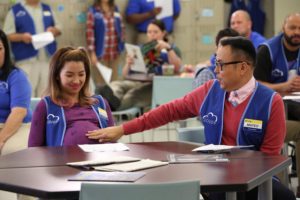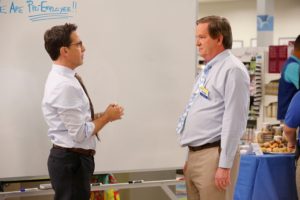
NBC’s new comedy, Superstore, takes place at a different kind of workplace than producer Justin Spitzer’s previous working life sitcom, The Office. But in transitioning from the world of conference rooms and memo writing to one of super-sales and cash registers, he brought his production designer, Michael G. Gallenberg, with him
Gallenberg mentions that he joined Spitzer in Season 3 of their previous hit, when there was an “already established look and style of the show.” So he had more of a tabula rasa — available on the stationary aisle! — going into the new show.
Any developing shorthand he’d had with the producer “was solidified during the preparation and filming,” of the show’s first season. “In fact it was Justin’s complete trust in me and my team to put the show together on a soundstage instead of a far away practical location that set the groundwork for our success. The wonderful work that Justin, director Ruben Fleischer and the entire cast and crew did on the pilot set the bar very high.”
A bar partially set because they used a real big box store for the pilot’s location, “so we had to be on our game to match that look with a fraction of the physical space.”
But in that fraction, is a meticulous eye for detail, down to such things as faux employee-posted Xeroxed car sale notices taped to soda machines in the break room (with missing phone number tags), and the store’s — Cloud 9 — own brand of reusable shopping bags, in the checkout lanes.
How Wal-Mart or Target-specific was the design? Was there a particular store in mind for Cloud 9?

“We used every existing big box store as an inspiration,” Gallenberg said, “but we really created our own special version of a superstore, given our restrictions of the stages. We really tried to create a unique corporate identity and we are still refining that identity with every episode. We created a shooting space that can give the illusion of great depth or support intimate scenes to service the needs of the stories. We also used a series of mirrors to give a visual extension to our ceilings. By reflecting back our drop ceiling it gives the illusion of a low partition wall you are looking over instead of a 14’ tall hard wall.”
But once the “shelves” were created, the next challenge, he says, was to fill them. “I don’t just mean the millions of pieces of set dressing but the 125+ gondolas themselves — the checkout aisles, the refrigerator and freezer sections, etc. All of the key areas were custom constructed or converted elements from manufacturers or liquidators,”
They also “recycled a lot of elements from defunct stores to get what we needed — and eight weeks goes by very fast. A show like this one doesn’t happen without an incredible amount of cooperation and support from the network and the studio down to the PA’s. Everyone shares in the success of Superstore more so than any other show I have had the pleasure to be a part of.”
A spread-the-credit team approach similar to the one Costco is renowned for — even if Superstore’s work environment is a bit more challenging for its on-screen employees.





